AI-Based Evaluation of Streets for People in Bangkok: Perspectives from Walkability and Lingerability
Abstract
:1. Introduction
2. Literature Review
2.1. Evaluating the Walkability of Streets
2.2. Streets and the Walking Situation in Bangkok
3. Methodology
3.1. AI-Based Street Evaluation
3.2. Input Data
4. Results
4.1. Results of Walkability Evaluation of Streets
4.2. Results of Lingerability Evaluation of Streets
4.3. Spatial Performance of Streets
5. Discussion
5.1. Evaluation of Accessibility Considering Resistance Due to Streets’ Spatial Performance
5.1.1. Accessibility Considering Psychological Resistance
5.1.2. Evaluation Results and Issues on the Current Soi
5.2. Consideration of Introducing Small Shared Mobility for Improved Accessibility
6. Conclusions
Author Contributions
Funding
Institutional Review Board Statement
Informed Consent Statement
Data Availability Statement
Conflicts of Interest
References
- WHO. WHO Global Status Report on Road Safety 2018; WHO: Geneva, Switzerland, 2018; p. 245. [Google Scholar]
- BTS Group Holdings PCL. Annual Report 2022/23 (FORM 56-1 ONE REPORT); BTS Group Holdings PCL: Bangkok, Thailand, 2023; pp. 36–40. [Google Scholar]
- Fukuda, A. Current Situation of Land Development in the Area along Rail Based Public Transport Systems in Bangkok—Limit and Possibility; IBS Annual Report; Kenkyu Katsudou Houkoku: Tokyo, Japan, 2017; pp. 71–76. [Google Scholar]
- Allison, G.H. Jumbo English-Thai Dictionary, 3rd ed.; Odeon Store: Bangkok, Thailand, 1978. [Google Scholar]
- Cohen, E. A soi in Bangkok: The dynamics of lateral urban expansion. J. Siam Soc. 1985, 73, 1–35. [Google Scholar]
- Watanabe, S.; Tsuboi, Y.; Akiyama, S.; Hoshihara, M.; Watanabe, Y. Study on characteristic of Urban street structure of Bangkok—A Relation of the Soi and Pakksoi in the Sukhumvit Area part1. Summ. Tech. Pap. Annu. Meet. Archit. Inst. Jpn. 2008, F-1, 969–970. [Google Scholar]
- Yingyeod, S. Soi Problem on the Rise. Bangkok Post 1971, 25, 7. [Google Scholar]
- Moreno, C.; Allam, Z.; Chabaud, D.; Gall, C.; Pratlong, F. Introducing the “15-Minute City”: Sustainability, Resilience and Place Identity in Future Post-Pandemic Cities. Smart Cities 2021, 4, 93–111. [Google Scholar] [CrossRef]
- Ulloa-Leon, F.; Correa-Parra, J.; Vergara-Perucich, F.; Cancino-Contreras, F.; Aguirre-Nuñez, C. “15-Minute City” and Elderly People: Thinking about Healthy Cities. Smart Cities 2023, 6, 1043–1058. [Google Scholar] [CrossRef]
- Khavarian-Garmsir, A.R.; Sharifi, A.; Hajian Hossein Abadi, M.; Moradi, Z. From Garden City to 15-Minute City: A Historical Perspective and Critical Assessment. Land 2023, 12, 512. [Google Scholar] [CrossRef]
- Eggimann, S. The potential of implementing superblocks for multifunctional street use in cities. Nat. Sustain. 2022, 5, 406–414. [Google Scholar] [CrossRef]
- Carra, M.; Rossetti, S.; Tiboni, M.; Vetturi, D. Urban regeneration effects on walkability scenarios. TeMA J. Land Use Mobil. Environ. 2022, 16, 101–114. [Google Scholar]
- Russo, A.; Campisi, T.; Tesoriere, G.; Annunziata, A.; Garau, C. Accessibility and Mobility in the Small Mountain Municipality of Zafferana Etnea (Sicily): Coupling of Walkability Assessment and Space Syntax. In Proceedings of the International Conference on Computational Science and Its Applications, Malaga, Spain, 4–7 July 2022; pp. 338–352. [Google Scholar]
- Thailand4.0—(thaiembdc.org). Available online: https://thaiembdc.org/thailand-4-0-2/ (accessed on 11 October 2023).
- Oizumi, K. “Thailand 4.0” toha nanika (zenpen)—Kouseityou-rosen ni kaji wo kiru Thai. Kan-Taiheiyou Bizinesu Zyouhou RIM 2017, 17, 91–103. [Google Scholar]
- The Project of Smart Transport Strategy for Thailand. Available online: https://www.jica.go.jp/project/thailand/034/index.html (accessed on 11 October 2023).
- Sou, K.; Kashima, S.; Yoh, K.; Doi, K. Evaluating the Performance of Walking Spaces Considering Passage and Retention Functions Using Image Recognition AI Model. J. Traffic Eng. 2022, 9, A_213–A_222. [Google Scholar]
- Sou, K.; Shiokawa, H.; Yoh, K.; Doi, K. Street Design for Hedonistic Sustainability through AI and Human Co-Operative Evaluation. Sustainability 2021, 13, 9066. [Google Scholar] [CrossRef]
- Baobeid, A.; Koç, M.; Al-Ghamdi, S.G. Walkability and Its Relationships with Health, Sustainability, and Livability: Elements of Physical Environment and Evaluation Frameworks. Front. Built Environ. 2021, 7, 721218. [Google Scholar] [CrossRef]
- Rafiemanzelat, R.; Emadi, I.M.; Kamali, J.A. City sustainability: The influence of walkability on built environments. Transp. Res. Procedia 2017, 24, 97–104. [Google Scholar] [CrossRef]
- Dowling, R.; Reinke, D. Multimodal Level of Service Analysis for Urban Streets, Users Guide; Transportation Research Board: Washington, DC, USA, 2008. [Google Scholar]
- John, I.G.; William, W.R.; Wesley, L.M. Does walkability matter? An examination of walkability’s impact on housing values, foreclosures and crime. Cities 2015, 42, 13–24. [Google Scholar]
- Lo, R.H. Walkability: What is it? J. Urban 2009, 2, 145–166. [Google Scholar] [CrossRef]
- Leslie, E.; Coffee, N.; Frank, L.; Owen, N.; Bauman, A.; Hugo, G. Walkability of local communities: Using geographic information systems to objectively assess relevant environmental attributes. Health Place 2007, 13, 111–122. [Google Scholar] [CrossRef] [PubMed]
- Villanueva, K.; Knuiman, M.; Nathan, A.; Giles-Corti, B.; Christian, H.; Foster, S.; Bull, F. The impact of neighborhood walkability on walking: Does it differ across adult life stage and does neighborhood buffer size matter? Health Place 2014, 25, 43–46. [Google Scholar] [CrossRef] [PubMed]
- Zhang, J.; Tan, P.Y.; Zeng, H.; Zhang, Y. Walkability assessment in a rapidly urbanizing city and its relationship with residential estate value. Sustainability 2019, 11, 2205. [Google Scholar] [CrossRef]
- Craig, C.L.; Brownson, R.C.; Cragg, S.E.; Dunn, A.L. Exploring the effect of the environment on physical activity: A study examining walking to work. Am. J. Prev. Med. 2002, 23, 36–43. [Google Scholar] [CrossRef]
- Clifton, K.J.; Smith, A.D.L.; Rodriguez, D. The development and testing of an audit for the pedestrian environment. Landsc. Urban Plan. 2007, 80, 95–110. [Google Scholar] [CrossRef]
- Day, K.; Boarnet, M.; Alfonzo, M.; Forsyth, A. The Irvine–Minnesota inventory to measure built environments: Development. Am. J. Prev. Med. 2006, 30, 144–152. [Google Scholar] [CrossRef] [PubMed]
- Saelens, B.E.; Handy, S.L. Built environment correlates of walking: A review. Med. Sci. Sports Exerc. 2008, 40 (Suppl. S7), S550. [Google Scholar] [CrossRef] [PubMed]
- Park, S.; Choi, K.; Lee, J.S. To walk or not to walk: Testing the effect of path walkability on transit users’ access mode choices to the station. Int. J. Sustain. Transp. 2015, 9, 529–541. [Google Scholar] [CrossRef]
- Otsuka, N.; Wittowsky, D.; Damerau, M.; Gerten, C. Walkability assessment for urban areas around railway stations along the Rhine-Alpine Corridor. J. Transp. Geogr. 2021, 93, 103081. [Google Scholar] [CrossRef]
- Kelly, C.E.; Tight, M.R.; Hodgson, F.C.; Page, M.W. A comparison of three methods for assessing the walkability of the pedestrian environment. J. Transp. Geogr. 2011, 19, 1500–1508. [Google Scholar] [CrossRef]
- Gkavra, R.; Nalmpantis, D.; Genitsaris, E.; Naniopoulos, A. The walkability of Thessaloniki: Citizens’ perceptions. Paving Way Sustain. Urban Mobil. 2019, 879, 191–198. [Google Scholar]
- Artigues, G.; Mateo, S.; Ramos, M.; Cabeza, E. Validation of the Urban Walkability Perception Questionnaire (UWPQ) in the Balearic Islands. Int. J. Environ. Res. Public Health 2020, 17, 6631. [Google Scholar] [CrossRef]
- Fonseca, F.; Papageorgiou, G.; Tondelli, S.; Ribeiro, P.; Conticelli, E.; Jabbari, M.; Ramos, R. Perceived walkability and respective urban determinants: Insights from Bologna and Porto. Sustainability 2022, 14, 9089. [Google Scholar] [CrossRef]
- Arshad, A.K.; Bahari, N.I.; Hashim, W.; Halim, A.A. Gender differences in pedestrian perception and satisfaction on the walkability of Kuala Lumpur city center. MATEC Web Conf. 2016, 47, 03003. [Google Scholar] [CrossRef]
- Gorrini, A.; Bertini, V. Walkability assessment and tourism cities: The case of Venice. Int. J. Tour. Cities 2018, 4, 355–368. [Google Scholar] [CrossRef]
- Millington, C.; Thompson, C.W.; Rowe, D.; Aspinall, P.; Fitzsimons, C.; Nelson, N. SPARColl—The Scottish Physical Activity Research Collaboration. Development of the Scottish walkability assessment tool (SWAT). Health Place 2009, 15, 474–481. [Google Scholar] [CrossRef]
- Isinkaralar, O.; Isinkaralar, K.; Sevik, H.; Küçük, Ö. Spatial modeling the climate change risk of river basins via climate classification: A scenario-based prediction approach for Türkiye. Nat. Hazards 2023, 1–18. [Google Scholar] [CrossRef]
- Isinkaralar, O. A Climate-Sensitive Approach for Determining the Urban Growth Boundaries: Towards a Spatial Exploration for Bursa, Türkiye. J. Urban Plan. Dev. 2023, 149, 4. [Google Scholar] [CrossRef]
- Isinkaralar, O.; Isinkaralar, K.; Bayraktar, E.P. Monitoring the spatial distribution pattern according to urban land use and health risk assessment on potential toxic metal contamination via street dust in Ankara, Türkiye. Environ. Monit. Assess. 2023, 195, 1085. [Google Scholar] [CrossRef] [PubMed]
- Isinkaralar, O.; Isinkaralar, K.; Yilmaz, D. Climate-related spatial reduction risk of agricultural lands on the Mediterranean coast in Türkiye and scenario-based modelling of urban growth. Environ. Dev. Sustain. 2023, 25, 13199–13217. [Google Scholar] [CrossRef]
- Stockton, J.C.; Duke-Williams, O.; Stamatakis, E.; Mindell, J.S.; Brunner, E.J.; Shelton, N.J. Development of a novel walkability index for London, United Kingdom: Cross-sectional application to the Whitehall II Study. BMC Public Health 2016, 16, 416. [Google Scholar] [CrossRef] [PubMed]
- Aultman-Hall, L.; Roorda, M.; Baetz, B.W. Using GIS for evaluation of neighborhood pedestrian accessibility. J. Urban Plan. Dev. 1997, 123, 10–17. [Google Scholar] [CrossRef]
- Owen, N.; Cerin, E.; Leslie, E.; Coffee, N.; Frank, L.D.; Bauman, A.E.; Sallis, J.F. Neighborhood walkability and the walking behavior of Australian adults. Am. J. Prev. Med. 2007, 33, 387–395. [Google Scholar] [CrossRef]
- Kuzmyak, J.; Baber, C.; Savory, D. Use of Walk Opportunities Index to Quantify Local Accessibility. Transp. Res. Rec. J. Transp. Res. Board 2006, 1977, 145–153. [Google Scholar] [CrossRef]
- Tsiompras, A.B.; Photis, Y.N. What matters when it comes to “Walk and the city”? Defining a weighted GIS-based walkability index. Transp. Res. Procedia 2017, 24, 523–530. [Google Scholar] [CrossRef]
- García-Palomares, J.C.; Gutiérrez, J.; Cardozo, O.D. Walking accessibility to public transport: An analysis based on microdata and GIS. Environ. Plan. B Plan. Des. 2013, 40, 1087–1102. [Google Scholar] [CrossRef]
- Frank, L.D.; Schmid, T.L.; Sallis, J.F.; Chapman, J.; Saelens, B.E. Linking objectively measured physical activity with objectively measured urban form: Findings from SMARTRAQ. Am. J. Prev. Med. 2005, 28, 117–125. [Google Scholar] [CrossRef] [PubMed]
- Frank, L.D.; Sallis, J.F.; Conway, T.L.; Chapman, J.E.; Saelens, B.E.; Bachman, W. Many Pathways from Land Use to Health: Associations between Neighborhood Walkability and Active Transportation, Body Mass Index, and Air Quality. J. Am. Plan. Assoc. 2007, 72, 75–87. [Google Scholar] [CrossRef]
- Isinkaralar, O. Bioclimatic comfort in urban planning and modeling spatial change during 2020–2100 according to climate change scenarios in Kocaeli, Türkiye. Int. J. Environ. Sci. Technol. 2023, 20, 7775–7786. [Google Scholar] [CrossRef]
- Walk Score Methodology. Available online: https://www.walkscore.com/methodology.shtml (accessed on 15 October 2023).
- Carr, L.J.; Dunsiger, S.I.; Marcus, B.H. Walk score as a global estimate of neighborhood walkability. Am. J. Prev. Med. 2010, 39, 460–463. [Google Scholar] [CrossRef] [PubMed]
- Duncan, D.T.; Aldstadt, J.; Whalen, J.; Melly, S.J.; Gortmaker, S.L. Validation of Walk Score® for estimating neighborhood walkability: An analysis of four US metropolitan areas. Int. J. Environ. Res. Public Health 2011, 8, 4160–4179. [Google Scholar] [CrossRef] [PubMed]
- Pongprasert, P.; Kubota, H. Switching from motorcycle taxi to walking: A case study of transit station access in Bangkok, Thailand. IATSS Res. 2017, 41, 182–190. [Google Scholar] [CrossRef]
- Townsend, C.; Zacharias, J. Built environment and pedestrian behavior at rail rapid transit stations in Bangkok. Transportation 2010, 37, 317–330. [Google Scholar] [CrossRef]
- Pueboobpaphan, R.; Pueboobpaphan, S.; Sukhotra, S. Acceptable walking distance to transit stations in Bangkok, Thailand: Application of a stated preference technique. J. Transp. Geogr. 2022, 99, 103296. [Google Scholar] [CrossRef]
- Chalermpong, S.; Wibowo, S.S. Transit station access trips and factors affecting propensity to walk to transit stations in Bangkok, Thailand. Proc. East. Asia Soc. Transp. Stud. 2007, 6, 232. [Google Scholar]
- Ozawa, H.; Fukuda, A.; Malaitham, S.; Vichiensan, V.; Luathep, P.; Numa, H. Evaluation of walking environments around urban railway stations in Bangkok and consideration of improvement plans. Asian Transp. Stud. 2021, 7, 100038. [Google Scholar] [CrossRef]
- Pongprasert, P.; Kubota, H. TOD residents’ attitudes toward walking to transit station: A case study of transit-oriented developments (TODs) in Bangkok, Thailand. J. Mod. Transp. 2019, 27, 39–51. [Google Scholar] [CrossRef]
- Zhang, F.; Zhou, B.; Liu, L.; Liu, Y.; Fung, H.H.; Lin, H.; Ratti, C. Measuring human perceptions of a large-scale urban region using machine learning. Landsc. Urban Plan. 2018, 180, 148–160. [Google Scholar] [CrossRef]
- Yao, Y.; Liang, Z.; Yuan, Z.; Liu, P.; Bie, Y.; Zhang, J.; Guan, Q. A human-machine adversarial scoring framework for urban perception assessment using street-view images. Int. J. Geogr. Inf. Sci. 2019, 33, 2363–2384. [Google Scholar] [CrossRef]
- Dubey, A.; Naik, N.; Parikh, D.; Raskar, R.; Hidalgo, C.A. Deep learning the city: Quantifying urban perception at a global scale. In Proceedings of the Computer Vision–ECCV 2016: 14th European Conference, Amsterdam, The Netherlands, 11–14 October 2016; pp. 196–212. [Google Scholar]
- Wei, J.; Yue, W.; Li, M.; Gao, J. Mapping human perception of urban landscape from street-view images: A deep-learning approach. Int. J. Appl. Earth Obs. Geoinf. 2022, 112, 102886. [Google Scholar] [CrossRef]
- Dai, L.; Zheng, C.; Dong, Z.; Yao, Y.; Wang, R.; Zhang, X.; Ren, S.; Zhang, J.; Song, X.; Guan, Q. Analyzing the correlation between visual space and residents’ psychology in Wuhan, China using street-view images and deep-learning technique. City Environ. Interact. 2021, 11, 100069. [Google Scholar] [CrossRef]
- Krizhevsky, A.; Sutskever, I.; Hinton, G.E. Imagenet classification with deep convolutional neural networks. Adv. Neural Inf. Process. Syst. 2012, 25. [Google Scholar] [CrossRef]
- Simonyan, K.; Zisserman, A. Very deep convolutional networks for large-scale image recognition. arXiv 2014, arXiv:1409.1556. [Google Scholar]
- Vichiensan, V.; Nakamura, K. Walkability Perception in Asian Cities: A Comparative Study in Bangkok and Nagoya. Sustainability 2021, 13, 6825. [Google Scholar] [CrossRef]
- 16th ATRANS Annual Conference. Available online: https://www.atransociety.com/atrans-website/?fbclid=IwAR3EjsMmhs-G2qF3Zf7qRefQ8XVk46HtWHMTP9Y-uSYrZzW5v7ezIUMdkEx0#conference (accessed on 27 November 2023).
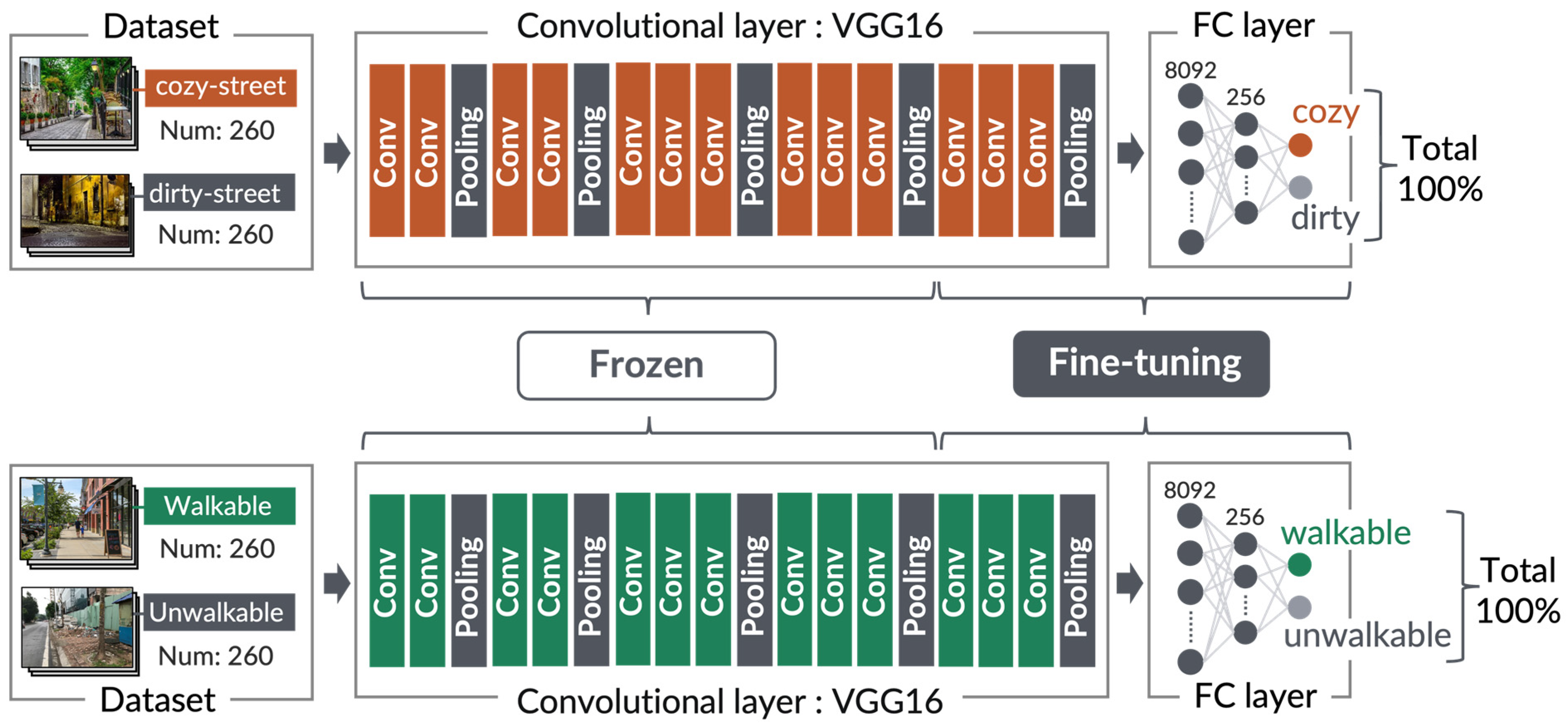

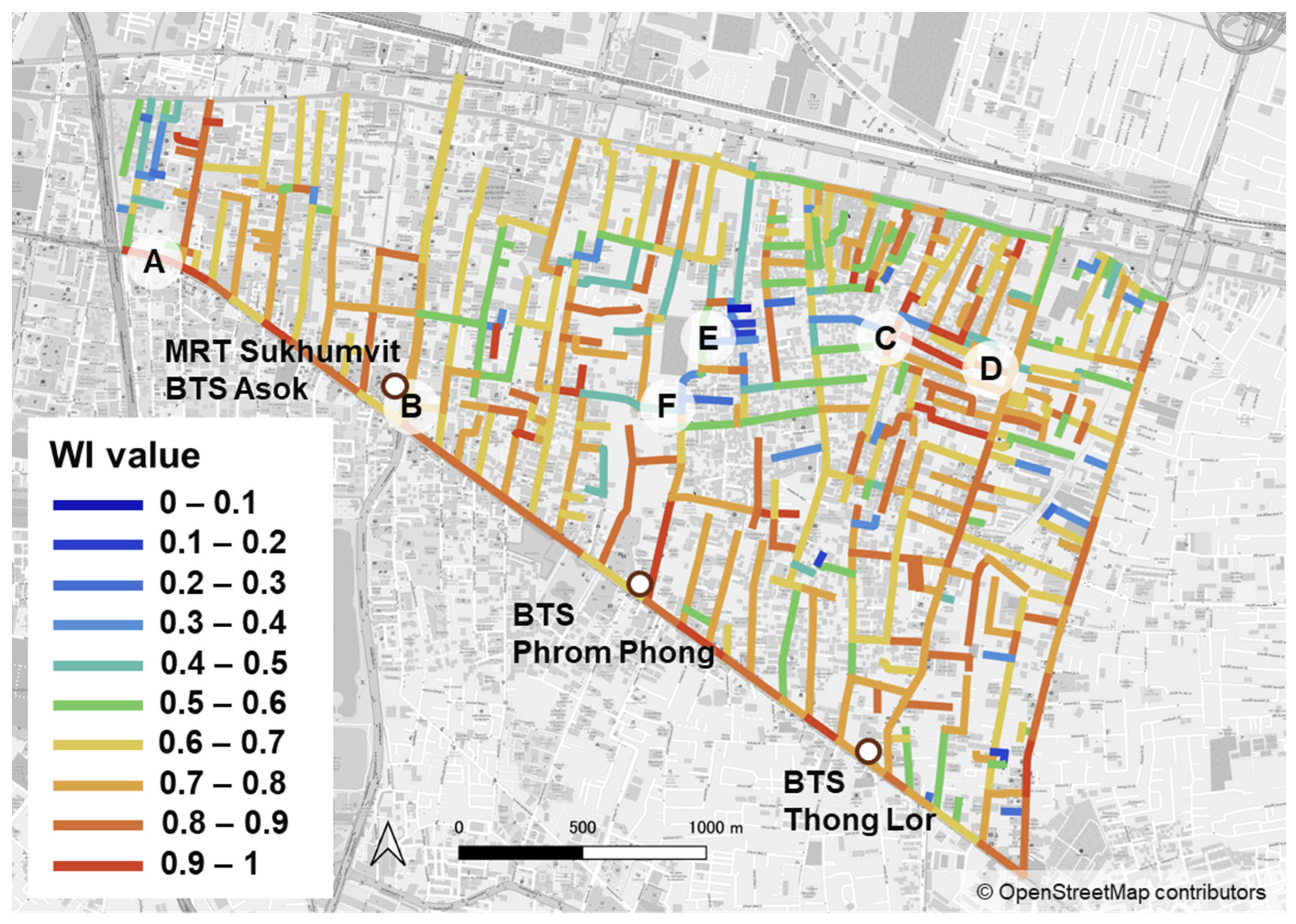
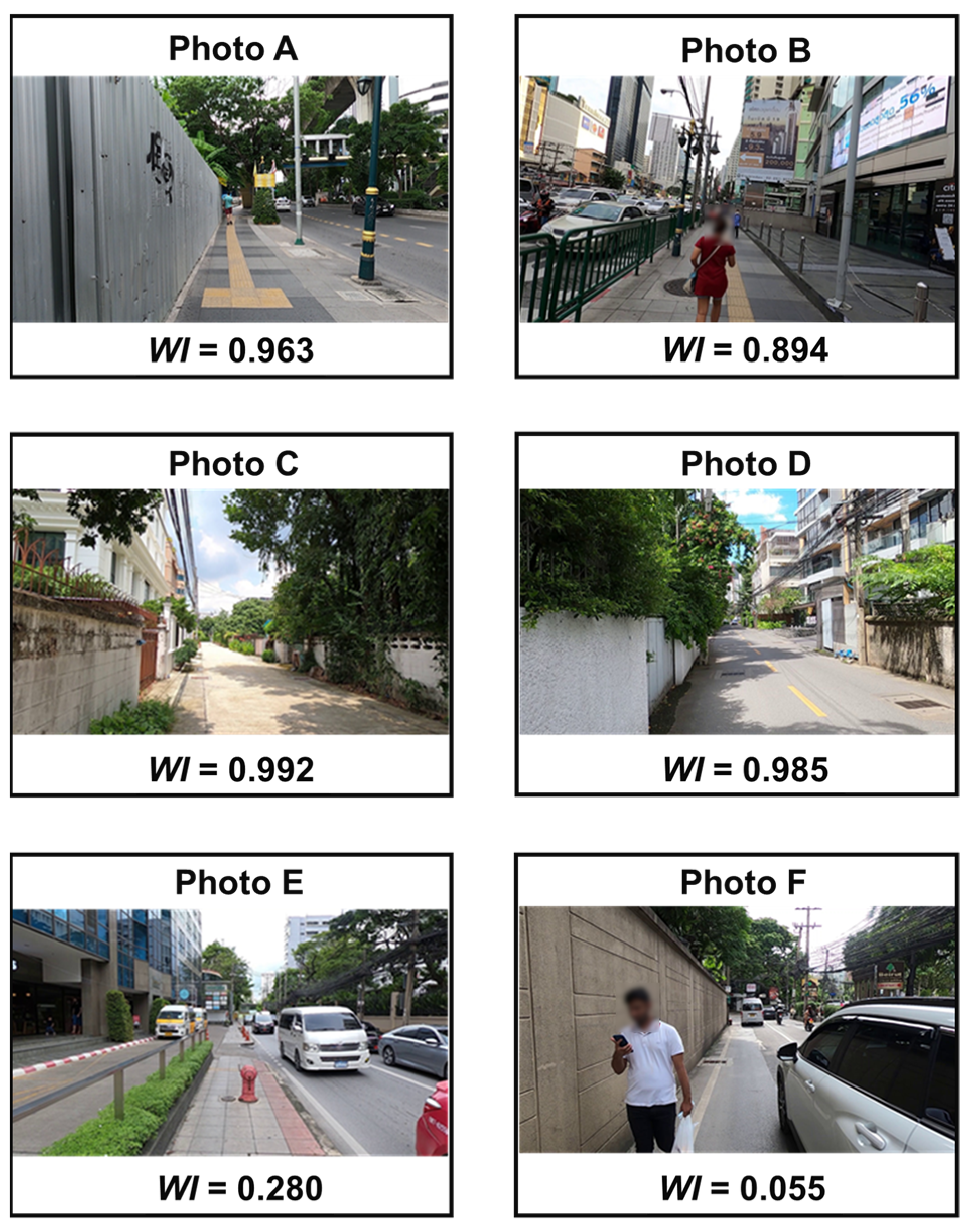
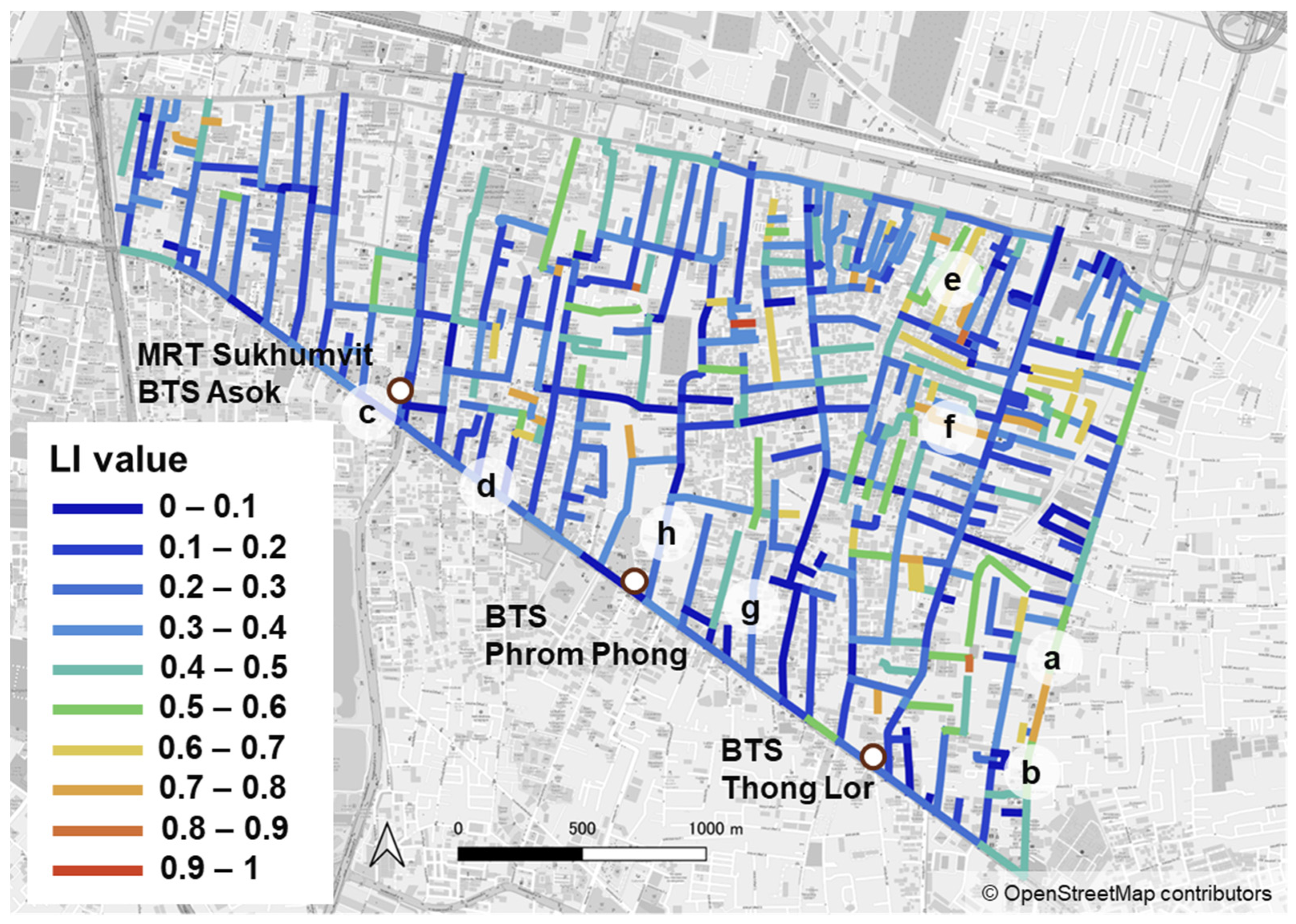


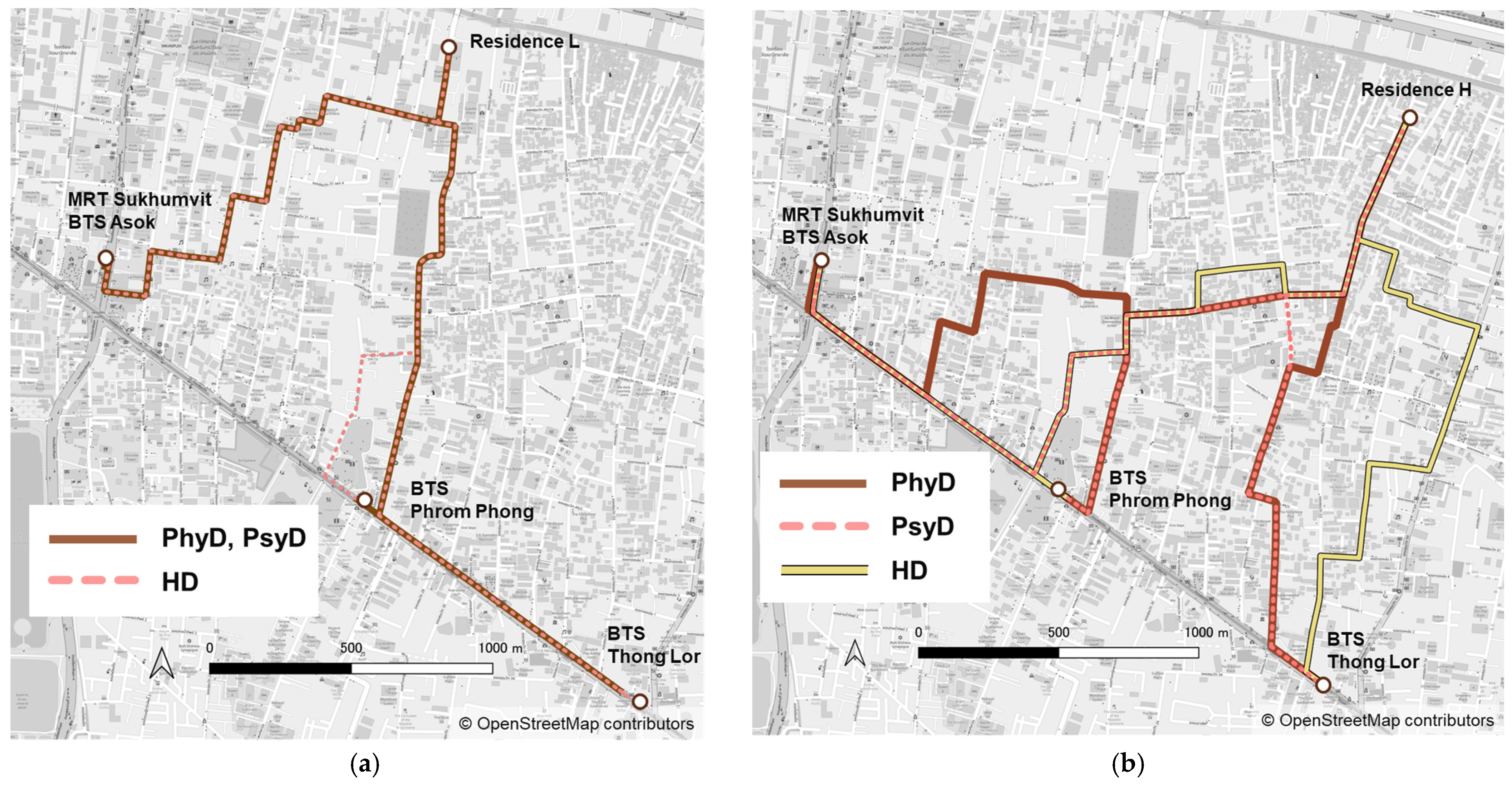
| Evaluation Indices | Search Keys | Number of Images | Training Data | Validation Data |
|---|---|---|---|---|
| Lingerability | cozy street | 260 | 220 | 40 |
| dirty street | 260 | 220 | 40 | |
| Walkability | walkable street | 260 | 220 | 40 |
| unwalkable street | 260 | 220 | 40 |
| From Residence L | From Residence H | |||||
|---|---|---|---|---|---|---|
| PhyD (m) | PsyD (m) | HD (m) | PhyD (m) | PsyD (m) | HD (m) | |
| To transit stations | ||||||
| BTS Phrom Phong | 1844 | 3163 | 12,925 | 2226 | 3138 | 12,362 |
| MRT Sukhumvit (BTS Asok) | 2263 | 3769 | 11,121 | 2386 | 3243 | 10,501 |
| BTS Thong Lor | 2802 | 4126 | 15,396 | 3284 | 4335 | 15,307 |
| To bus stops | ||||||
| Bts Prompong/Ssp Tower 1 | 1732 | 3035 | 11,852 | 1462 | 2233 | 5483 |
| Emquartier/Ekkamai 19 | 1846 | 3102 | 10,212 | 1535 | 2222 | 4988 |
| Rsu tower/Soi Ekkamai 11 | 1894 | 3160 | 10,659 | 1727 | 2416 | 5685 |
Disclaimer/Publisher’s Note: The statements, opinions and data contained in all publications are solely those of the individual author(s) and contributor(s) and not of MDPI and/or the editor(s). MDPI and/or the editor(s) disclaim responsibility for any injury to people or property resulting from any ideas, methods, instructions or products referred to in the content. |
© 2023 by the authors. Licensee MDPI, Basel, Switzerland. This article is an open access article distributed under the terms and conditions of the Creative Commons Attribution (CC BY) license (https://creativecommons.org/licenses/by/4.0/).
Share and Cite
Bando, Y.; Yoh, K.; Sou, K.; Chou, C.-C.; Doi, K. AI-Based Evaluation of Streets for People in Bangkok: Perspectives from Walkability and Lingerability. Sustainability 2023, 15, 16884. https://doi.org/10.3390/su152416884
Bando Y, Yoh K, Sou K, Chou C-C, Doi K. AI-Based Evaluation of Streets for People in Bangkok: Perspectives from Walkability and Lingerability. Sustainability. 2023; 15(24):16884. https://doi.org/10.3390/su152416884
Chicago/Turabian StyleBando, Yuka, Kento Yoh, Kanyou Sou, Chun-Chen Chou, and Kenji Doi. 2023. "AI-Based Evaluation of Streets for People in Bangkok: Perspectives from Walkability and Lingerability" Sustainability 15, no. 24: 16884. https://doi.org/10.3390/su152416884
APA StyleBando, Y., Yoh, K., Sou, K., Chou, C.-C., & Doi, K. (2023). AI-Based Evaluation of Streets for People in Bangkok: Perspectives from Walkability and Lingerability. Sustainability, 15(24), 16884. https://doi.org/10.3390/su152416884








